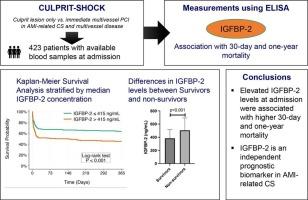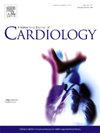胰岛素样生长因子结合蛋白2 (IGFBP-2)作为梗死相关性心源性休克的预后参数
IF 3.2
2区 医学
Q2 CARDIAC & CARDIOVASCULAR SYSTEMS
引用次数: 0
摘要
背景:急性心肌梗死(AMI)致心源性休克(CS)是一种死亡率高的危重疾病。胰岛素样生长因子结合蛋白2 (IGFBP-2)在心血管疾病中失调。本研究的目的是探讨IGFBP-2在AMI-CS患者中的预后价值。方法:本研究是随机多中心罪犯休克试验的事后分析。使用市售酶联免疫吸附测定(ELISA)试剂盒检测423例患者血清样本中的IGFBP-2水平。研究IGFBP-2与30天和1年死亡率的关系。结果:IGFBP-2中位浓度为415 ng/ml (IQR 274-699 ng/ml)。IGFBP-2 ≥ 的患者30天的中位数较高(54. % vs. 37. %;p )结论:在AMI-CS中,IGFBP-2水平升高与入院后30 天和1年的较高死亡率相关。IGFBP-2是一种很有前景的预后生物标志物,可以为高风险患者队列的风险分层增加价值,可能为早期临床决策提供信息。本文章由计算机程序翻译,如有差异,请以英文原文为准。

Insulin-like growth factor binding protein 2 (IGFBP-2) as prognostic parameter in infarct-related cardiogenic shock
Background
Cardiogenic shock (CS) caused by acute myocardial infarction (AMI) is a critical condition with high mortality rate. Insulin-like growth factor binding protein 2 (IGFBP-2) is dysregulated in cardiovascular diseases. The purpose of the present study was to investigate the prognostic value of IGFBP-2 in patients with AMI-CS.
Methods
This study is a post-hoc analysis of the randomized multicentre CULPRIT-SHOCK trial. IGFBP-2 levels were measured in serum samples from 423 patients using commercially available enzyme-linked immunosorbent assay (ELISA) kits. Associations of IGFBP-2 with 30-day and one-year mortality were investigated.
Results
Median IGFBP-2 concentration was 415 ng/ml (IQR 274–699 ng/ml). Patients with IGFBP-2 ≥ median demonstrated higher 30-day (54 % vs. 37 %; p < 0.001) and one-year mortality (60 % vs. 42 %; p < 0.001) compared to the < median group. Higher IGFBP-2 concentrations were associated with increased 30-day and one-year mortality, irrespective of it being analysed as continuous or categorical variable (per 100 ng/ml IGFBP-2, hazard ratio (HR) 1.06; 95 % confidence interval (CI) 1.04–1.09; p < 0.001, respectively; IGFBP-2 ≥ vs. < median, HR 1.70, 95 % CI 1.23–2.35, p = 0.001 and HR 1.72, 95 %CI 1.27–2.33, p < 0.001). Furthermore, IGFBP-2 ≥ median was associated with increased 30-day (HR 1.70; 95 %CI 1.23–2.35; p = 0.001) and one-year mortality (HR 1.72; 95 %CI 1.27–2.33; p < 0.001), even after adjustment for established prognostic factors.
Conclusions
In AMI-CS, elevated levels of IGFBP-2 were associated with higher mortality at 30 days and one year after admission. IGFBP-2 represents a promising prognostic biomarker and could add value to risk stratification in this high-risk patient cohort, potentially informing early clinical decision-making.
求助全文
通过发布文献求助,成功后即可免费获取论文全文。
去求助
来源期刊

International journal of cardiology
医学-心血管系统
CiteScore
6.80
自引率
5.70%
发文量
758
审稿时长
44 days
期刊介绍:
The International Journal of Cardiology is devoted to cardiology in the broadest sense. Both basic research and clinical papers can be submitted. The journal serves the interest of both practicing clinicians and researchers.
In addition to original papers, we are launching a range of new manuscript types, including Consensus and Position Papers, Systematic Reviews, Meta-analyses, and Short communications. Case reports are no longer acceptable. Controversial techniques, issues on health policy and social medicine are discussed and serve as useful tools for encouraging debate.
 求助内容:
求助内容: 应助结果提醒方式:
应助结果提醒方式:


